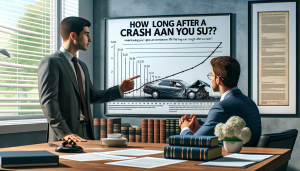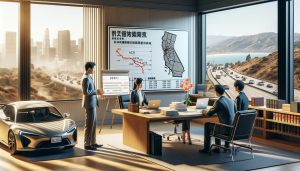Introduction
Auto accidents occur daily, often with devastating consequences, but understanding their causes can play a crucial role in preventing them. Have you ever wondered why accidents happen and what you can do to minimize risks? Whether it's human error, environmental factors, or vehicle issues, there are specific actions you can take to safeguard yourself and others on the road. Let’s dive deeper into the top causes of accidents and explore practical, actionable solutions to help ensure safer journeys.
Distracted Driving
Distracted driving has become one of the most pervasive and preventable causes of accidents. Imagine trying to juggle while running—it’s a recipe for disaster. Everyday activities like texting, eating, or adjusting the radio might seem harmless, but they take your focus away from the road for crucial moments. Even glancing at your phone for five seconds while driving at 55 mph means you’ve traveled the length of a football field blindfolded. These moments of inattention can lead to collisions with life-changing or fatal consequences.
Solution:
- Keep your phone out of reach or use hands-free technology.
- Avoid multitasking; focus solely on driving.
- Educate others about the dangers of distracted driving through campaigns or conversations.

Speeding
Speeding might save you a few minutes, but it drastically increases the likelihood of an accident. Driving faster than the speed limit reduces the time you have to react to hazards, such as sudden stops or unexpected obstacles. Additionally, higher speeds amplify the force of a crash, leading to more severe injuries or fatalities.
Solution:
- Plan your trips with extra time to avoid feeling rushed.
- Use cruise control on highways to maintain a steady speed.
- Remember that arriving late is better than not arriving at all.
Driving Under the Influence
Driving under the influence of alcohol or drugs is not only illegal but also one of the deadliest decisions a driver can make. Impaired judgment, slower reaction times, and reduced coordination create a perfect storm for accidents. Each year, thousands of lives are lost or forever changed due to preventable DUI-related crashes.
Solution:
- Never drive after consuming alcohol or drugs.
- Arrange for a designated driver or use rideshare services.
- If you suspect someone is driving under the influence, report it to the authorities.
Weather Conditions
Adverse weather conditions like rain, snow, ice, and fog transform roads into slippery, unpredictable hazards. Reduced visibility and poor traction make even the most experienced drivers vulnerable to accidents. Hydroplaning in the rain or skidding on icy roads can happen in seconds, leaving little room for corrective actions.
Solution:
- Slow down and increase your following distance during bad weather.
- Use headlights appropriately to improve visibility.
- Ensure your tires and windshield wipers are in good condition.
Poor Road Conditions
Neglected road infrastructure poses hidden dangers for drivers. Potholes, missing road signs, uneven surfaces, and inadequate lighting can force drivers into sudden maneuvers like swerving or abrupt braking. Such actions can lead to collisions or loss of vehicle control, especially at high speeds.
Solution:
- Stay alert for potential road hazards and drive defensively.
- Report poor road conditions to local authorities.
- Drive at a safe speed to allow more reaction time for unexpected obstacles.
Vehicle Malfunctions
Mechanical failures, such as brake malfunctions, tire blowouts, or engine problems, are often the result of neglected maintenance. When your vehicle isn’t operating at peak performance, it increases the chances of an accident, especially in high-pressure situations that require quick stops or maneuvers.
Solution:
- Schedule regular vehicle inspections and maintenance.
- Pay attention to warning signs like unusual noises or dashboard alerts.
- Keep an emergency roadside kit in your car for unexpected breakdowns.
Aggressive Driving and Road Rage
Aggressive driving behaviors like tailgating, cutting off other drivers, or making sudden stops create unnecessary risks on the road. Road rage can escalate these situations further, leading to impulsive actions that put everyone in danger. Emotional responses, such as anger or frustration, have no place behind the wheel.
Solution:
- Practice patience and avoid reacting to other drivers’ mistakes.
- Use defensive driving techniques to maintain a safe distance.
- If you feel overwhelmed or angry, pull over and take a moment to cool down.
Auto accidents are not just unpredictable events—they’re often preventable with the right precautions and habits. By incorporating safe driving practices into your daily routine, you can significantly reduce the likelihood of accidents and protect yourself and others on the road. Here’s an expanded guide to help you drive smarter and safer.
Stay Focused on the Road
Distracted driving is a leading cause of accidents, but staying focused can prevent most of these incidents. Set your GPS and adjust mirrors, seat positions, and climate controls before starting your trip. Keep your phone out of reach, use hands-free devices for calls, and avoid eating, drinking, or fiddling with controls while driving. Driving should always be your primary focus—it’s a responsibility that demands your full attention.
Tips for Staying Focused:
- Limit passenger-related distractions by setting boundaries, especially with children or pets.
- Use apps that block notifications while driving to prevent temptation.
- If you feel tired or distracted, pull over safely to rest or regroup.
Obey Speed Limits
Speed limits are carefully calculated based on road conditions, traffic patterns, and safety considerations. Exceeding these limits reduces your reaction time and increases the severity of accidents. Driving at or below the posted speed helps you stay in control and adapt to unexpected changes on the road, such as sudden stops or sharp curves.
How to Maintain Safe Speeds:
- Use cruise control on highways to avoid unintentional speeding.
- Keep an eye on speed limit signs, especially in unfamiliar areas.
- Adjust your speed to match conditions, such as heavy traffic or construction zones.
Avoid Driving Under the Influence
Impairment due to alcohol, drugs, or even certain medications is a major contributor to road accidents. Driving under the influence affects your judgment, coordination, and reaction times, making it nearly impossible to operate a vehicle safely. Opt for alternatives like rideshare services, public transportation, or a trusted designated driver if you’re not in a condition to drive.
Preventive Measures:
- Plan ahead by arranging transportation before going out.
- Keep a list of local taxi or rideshare services handy.
- If hosting an event, encourage guests to use sober ride options.
Adapt to Weather Conditions
Rain, snow, fog, and ice create hazardous driving conditions that require extra caution. Reduced visibility and slick surfaces make it more challenging to control your vehicle and stop in time. Adjusting your driving habits to accommodate these conditions is essential for safety.
Weather-Specific Tips:
- Drive slower than usual and leave extra space between vehicles.
- Use low-beam headlights in fog to improve visibility without glare.
- Equip your vehicle with seasonal tires and ensure wipers are in good condition.
Maintain Your Vehicle Regularly
Your car’s condition directly impacts your safety. Neglecting routine maintenance can lead to mechanical failures, such as tire blowouts or brake malfunctions, which increase the risk of accidents. Regular inspections and tune-ups can catch potential issues before they become problems.
Maintenance Checklist:
- Check tire pressure, tread depth, and alignment regularly.
- Replace worn-out brake pads and top off fluids, including oil and coolant.
- Ensure all lights and signals are functioning properly.
Practice Defensive Driving
Defensive driving is about anticipating potential hazards and being prepared to respond. This proactive approach includes maintaining a safe following distance, scanning your surroundings, and avoiding aggressive maneuvers. By staying calm and alert, you can make better decisions and avoid collisions caused by other drivers’ mistakes.
Key Defensive Driving Techniques:
- Keep at least three seconds of distance between you and the car ahead.
- Avoid blind spots by positioning yourself for optimal visibility.
- Stay aware of escape routes in case of sudden stops or emergencies.
Plan Your Routes
Preparation can reduce stress and the likelihood of
accidents. Use GPS or check traffic updates before heading out to avoid congested or high-risk areas. Familiarizing yourself with your route also helps you anticipate turns and exits, reducing the chance of last-minute lane changes.
Route Planning Tips:
- Save alternate routes in case of unexpected delays.
- Avoid high-traffic times if possible, such as rush hours.
- Use navigation apps with real-time updates for traffic and road conditions.
The Role of Technology in Accident Prevention
Technology plays a vital role in making roads safer. From advanced driver assistance systems to smartphone apps, modern tools are designed to help drivers stay alert and minimize risks.
Advanced Driver Assistance Systems (ADAS):
Features like lane departure warnings, automatic emergency braking, and adaptive cruise control provide real-time assistance and act as an extra layer of protection. These systems are especially useful for long drives or in heavy traffic, where driver fatigue is more likely.
Smartphone Apps for Safer Driving:
Apps like “Drive Safe” and “TrueMotion” monitor your habits, reward safe driving, and provide helpful feedback. Some even disable notifications to minimize distractions.
The Legal and Financial Implications of Auto Accidents
Beyond the immediate physical and emotional toll,
auto accidents carry significant legal and financial burdens. Understanding these implications can help you make informed decisions before and after a crash.
Understanding Liability:
Determining fault is crucial for insurance claims and legal proceedings. Knowing your rights and responsibilities ensures you’re prepared to handle disputes and receive fair compensation.
Accidents can lead to medical bills, repair costs, legal fees, and increased insurance premiums. The financial strain underscores the importance of prevention—it’s far more affordable and less stressful than dealing with the aftermath of a crash.

Conclusion
Safe driving is about making informed, conscious decisions every time you get behind the wheel. By staying focused, obeying traffic laws, and leveraging technology, you can minimize risks and contribute to safer roads. Prevention is not just about protecting yourself—it’s about safeguarding everyone who shares the road with you. Every choice you make as a driver matters, so commit to safer driving habits today and set an example for others.
Look for an attorney who has the right legal resources for your legal needs.
Contact us here on the
Warmuth Law website or through our hotline 888-517-9888.
Frequently Asked Questions (FAQ's)
1. What is the most common cause of car accidents?
Distracted driving is the leading cause, including activities like texting or eating while driving.
2. How can I avoid accidents during bad weather?
Drive slower, use your headlights, and increase your following distance to improve safety.
3. What should I do immediately after an accident?
Check for injuries, move to a safe location, call emergency services, and exchange information with other parties.
4. Are newer cars safer in preventing accidents?
Yes, modern cars often come with advanced safety features like ADAS, which can help prevent accidents.
5. How often should I maintain my vehicle to ensure safety?
Regular maintenance, including oil changes and brake checks, should be performed every 3,000 to 5,000 miles or as recommended by your car manufacturer.












